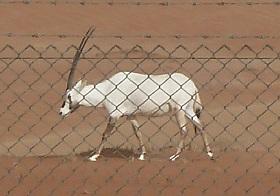Using AI to control energy for indoor agriculture
30 September 2024
Published online 5 December 2012

Researchers in Qatar have mapped the genome of the vulnerable Arabian oryx. Distinct for its spear-like horns, this antelope has survived in zoos and nature reserves after it was classified as extinct in the 1970s. It was only reclassified as 'vulnerable' by the International Union for Conservation of Nature in 2011 after captive-breeding programmes brought the species back from the brink.
Conservationists and researchers hope to better understand the genetic diversity among extant populations of oryx as decades of intensive interbreeding between oryx has narrowed the genetic diversity and threatens the species long-term survival.
The genome sequenced in this study, which was retrieved from a young male oryx kept at Qatar's Al Wabra Wildlife Preservation, confirms conservationists' fears that genetic diversity is indeed very low.
Joel Malek, the lead geneticist who carried out the work at Qatar's Weil Cornell Medical College in Doha, cautions that the low genetic diversity observed may be evident only within the captive population at Al Wabra Wildlife Preservation. The only way to be sure is to sequence genomes from other captive populations.
"That is certainly our next step," Malek says. He hopes to start sequencing at least 5–10 oryx from different herds to better understand the genetic status quo. However, what makes this first genome mapping particularly challenging is the lack of any oryx genome references.
"This was a de novo sequence and assembly which requires special DNA libraries and fairly large computational infrastructure," he says. Sequencing the genomes of other oryx will be significantly easier and cheaper now that they have a rough draft of the animal's genome. While the first sequencing cost ~US$ 300,000, further sequencings will like cost only US$ 10,000.
"We would like to start sequencing them as soon as possible, but we're waiting on funding from the various parties involved," adds Malek.
The low variation observed is most likely a direct consequence of the oryx being among the rarest mammals in the world.
The researchers hope the genomic data will help identify the most genetically different male and female oryx so that their offspring have greater genetic diversity, making any offspring healthier and more resistant to disease.
Till then, the data from a single genome may not be of much use in breeding programmes. Alexei Lobanov, a geneticist at Harvard Medical School's Brigham and Women's Hospital in Boston, Massachusetts, whose research team sequenced the genome of the naked mole rat, cautions against jumping to conclusions. "What if this particular oryx has some genetic disease?" he notes, emphasizing the limit such a single study can have on distinguishing between characteristic features of a species and the features of a single sample studied.
Nevertheless, he explains that researchers can look at DNA sequence variations — technically called single-nucleotide polymorphisms (SNP) — within a single specimen to get insights into the genetics of the species as a whole. "I found the low number of SNPs in the Arabian oryx genome to be quite intriguing," Lobanov says. "It is indeed significantly lower than in other mammals."
Lobanov suggests two possible explanations for this finding: either more SNPs were not detected due to technological obstacles that limited the amount of the genome covered, or genetic diversity is actually very low. However, Lobanov dismisses the first option, noting Malek's research teams' 90% coverage of the oryx's genome and their straightforward SNP detection methods.
"This means that the low variation observed is most likely a direct consequence of the oryx being among the rarest mammals in the world," he says. "This makes their data even more valuable."
He stresses that the current data is too limited, and notes that artificially-induced diversity can backfire in unexpected ways. "Let me put it this way: if you are working on a computer, it is always a good thing to have a backup. Then, when something goes wrong, you can always restore your system and try again. Well, thanks to Qatar's Weil Cornell Medical College, we now have a backup of the oryx's genome. Or, at least, 90% of it."
doi:10.1038/nmiddleeast.2012.171
Stay connected: